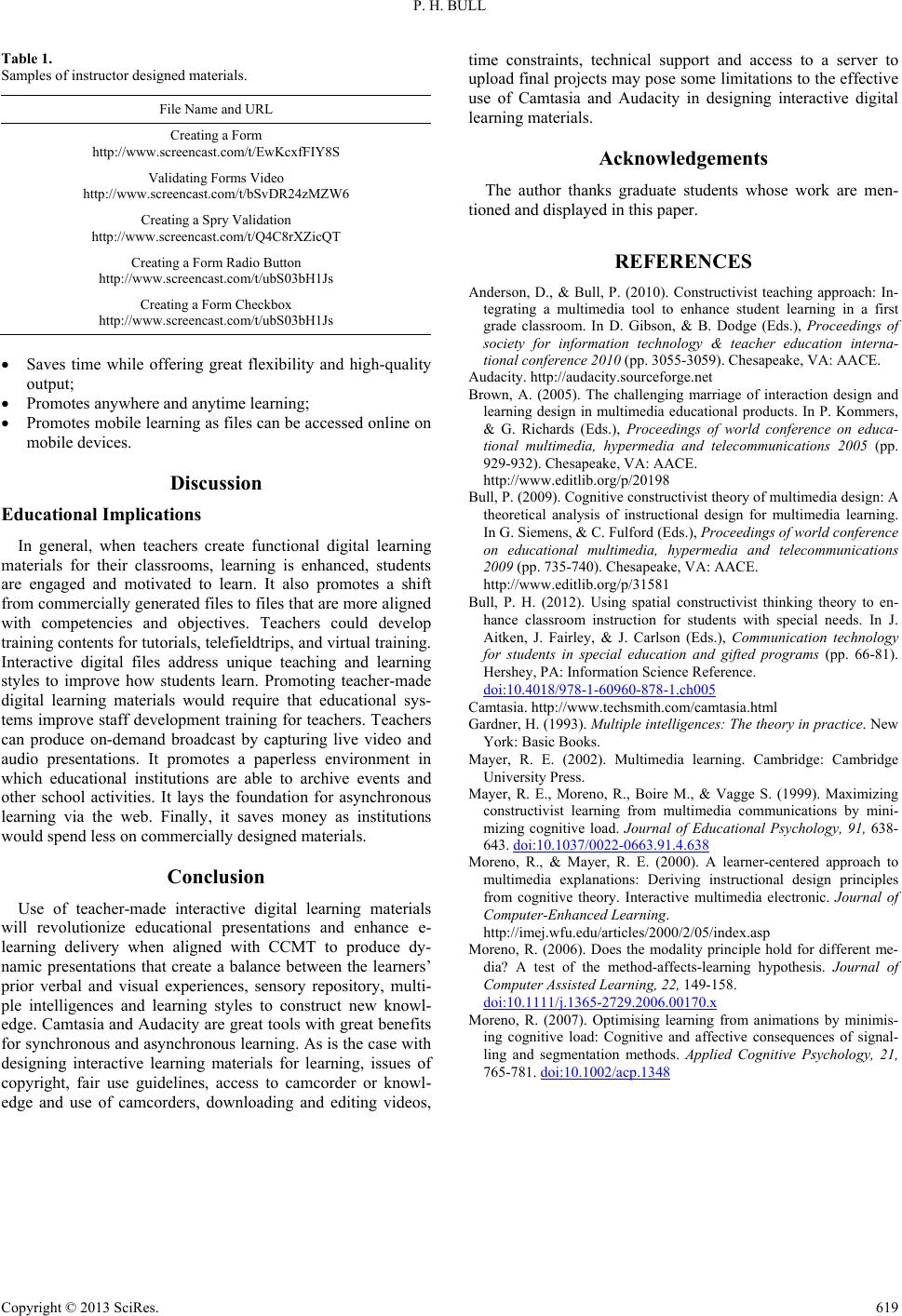
P. H. BULL
Copyright © 2013 SciRe s . 619
Table 1.
Samples of instructor designed materials.
File Name and URL
Creating a Form
http://www.screencast.com/t/EwKcxfFIY8S
Validating Forms Video
http://www.screencast.com/t/bSvDR24zMZW6
Creating a S p r y Validation
http://www.screencast.com/t/Q4C8rXZicQT
Creating a F orm Radio Button
http://www.screencast.com/t/ubS03bH1Js
Creating a For m Check box
http://www.screencast.com/t/ubS03bH1Js
Saves time while offering great flexibility and high-quality
output;
Promotes anywhere and anytime learning;
Promotes mobile learning as files can be accessed online on
mobile devices.
Discussion
Educational Implications
In general, when teachers create functional digital learning
materials for their classrooms, learning is enhanced, students
are engaged and motivated to learn. It also promotes a shift
from commercially generated files to files that are more aligned
with competencies and objectives. Teachers could develop
training contents for tutorials, telefieldtrips, and virtual training.
Interactive digital files address unique teaching and learning
styles to improve how students learn. Promoting teacher-made
digital learning materials would require that educational sys-
tems improve staff development training for teachers. Teachers
can produce on-demand broadcast by capturing live video and
audio presentations. It promotes a paperless environment in
which educational institutions are able to archive events and
other school activities. It lays the foundation for asynchronous
learning via the web. Finally, it saves money as institutions
would spend less on commercially designed ma terials.
Conclusion
Use of teacher-made interactive digital learning materials
will revolutionize educational presentations and enhance e-
learning delivery when aligned with CCMT to produce dy-
namic presentations that create a balance between the learners’
prior verbal and visual experiences, sensory repository, multi-
ple intelligences and learning styles to construct new knowl-
edge. Camtasia and Audacity are great tools with great benefits
for synchronous and asynchronous learning. As is the case with
designing interactive learning materials for learning, issues of
copyright, fair use guidelines, access to camcorder or knowl-
edge and use of camcorders, downloading and editing videos,
time constraints, technical support and access to a server to
upload final projects may pose some limitations to the effective
use of Camtasia and Audacity in designing interactive digital
learning ma terials.
Acknowledgements
The author thanks graduate students whose work are men-
tioned and displayed in this paper.
REFERENCES
Anderson, D., & Bull, P. (2010). Constructivist teaching approach: In-
tegrating a multimedia tool to enhance student learning in a first
grade classroom. In D. Gibson, & B. Dodge (Eds.), Proceedings of
society for information technology & teacher education interna-
tional conference 2010 (pp. 3055-3059). Chesapeake, VA: AACE.
Audacity. http://audacity.sourceforge.net
Brown, A. (2005). The challenging marriage of interaction design and
learning design in multimedia educational products. In P. Kommers,
& G. Richards (Eds.), Proceedings of world conference on educa-
tional multimedia, hypermedia and telecommunications 2005 (pp.
929-932). Chesapeake, VA: AACE.
http://www.editlib.org/p/20198
Bull, P. (2009). Cognitive constructivist theory of multimedia design: A
theoretical analysis of instructional design for multimedia learning.
In G. Siemens, & C. Fulford (Eds.), Proceedings of world conference
on educational multimedia, hypermedia and telecommunications
2009 (pp. 735-740). Chesapeake, VA: AACE.
http://www.editlib.org/p/31581
Bull, P. H. (2012). Using spatial constructivist thinking theory to en-
hance classroom instruction for students with special needs. In J.
Aitken, J. Fairley, & J. Carlson (Eds.), Communication technology
for students in special education and gifted programs (pp. 66-81).
Hershey, PA: Information Science Reference.
doi:10.4018/978-1-60960-878-1.ch005
Camtasia. http://www.techsmith.com/camtasia.html
Gardner, H. (1993). Multiple intelligences: The theory in practice. New
York: Basic Books.
Mayer, R. E. (2002). Multimedia learning. Cambridge: Cambridge
University Press.
Mayer, R. E., Moreno, R., Boire M., & Vagge S. (1999). Maximizing
constructivist learning from multimedia communications by mini-
mizing cognitive load. Journal of Educational Psychology, 91, 638-
643. doi:10.1037/0022-0663.91.4.638
Moreno, R., & Mayer, R. E. (2000). A learner-centered approach to
multimedia explanations: Deriving instructional design principles
from cognitive theory. Interactive multimedia electronic. Journal of
Computer-Enhanced Le ar n in g.
http://imej.wfu.edu/articles/2000/2/05/index.asp
Moreno, R. (2006). Does the modality principle hold for different me-
dia? A test of the method-affects-learning hypothesis. Journal of
Computer Assisted Learning, 22, 149-158.
doi:10.1111/j.1365-2729.2006.00170.x
Moreno, R. (2007). Optimising learning from animations by minimis-
ing cognitive load: Cognitive and affective consequences of signal-
ling and segmentation methods. Applied Cognitive Psychology, 21,
765-781. doi:10.1002/acp.1348